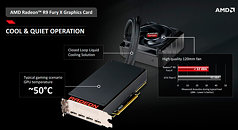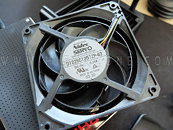- Joined
- Oct 9, 2007
- Messages
- 47,448 (7.50/day)
- Location
- Hyderabad, India
| System Name | RBMK-1000 |
|---|---|
| Processor | AMD Ryzen 7 5700G |
| Motherboard | ASUS ROG Strix B450-E Gaming |
| Cooling | DeepCool Gammax L240 V2 |
| Memory | 2x 8GB G.Skill Sniper X |
| Video Card(s) | Palit GeForce RTX 2080 SUPER GameRock |
| Storage | Western Digital Black NVMe 512GB |
| Display(s) | BenQ 1440p 60 Hz 27-inch |
| Case | Corsair Carbide 100R |
| Audio Device(s) | ASUS SupremeFX S1220A |
| Power Supply | Cooler Master MWE Gold 650W |
| Mouse | ASUS ROG Strix Impact |
| Keyboard | Gamdias Hermes E2 |
| Software | Windows 11 Pro |
AMD's upcoming flagship GPU silicon, codenamed "Fiji," which is breaking ground on new technologies, such as HBM, memory-on-package, a specialized substrate layer that connects the GPU with it, called Interposer; features a hefty feature-set. More on the "Fiji" package and its memory implementation, in our older article. Its block diagram (manufacturer-drawn graphic showing the GPU's component hierarchy), reveals a scaling up, of the company's high-end GPU launches over the past few years.
"Fiji" retains the quad Shader Engine layout of "Hawaii," but packs 16 GCN Compute Units (CUs), per Shader Engine (compared to 11 CUs per engine on Hawaii). This works out to a stream processor count of 4,096. Fiji is expected to feature a newer version of the Graphics CoreNext architecture than "Hawaii." The TMU count is proportionately increased, to 256 (compared to 176 on "Hawaii"). AMD doesn't appear to have increased the ROP count, which is still at 64. The most significant change, however, is its 4096-bit HBM memory interface, compared to 512-bit GDDR5 on "Hawaii."





At its given clock speeds, of up to 1050 MHz core, with 500 MHz memory (512 GB/s bandwidth), on the upcoming Radeon R9 Fury X graphics card, "Fiji" offers a GPU compute throughput of 8.6 TFLOP/s, which is greater than the 7 TFLOP/s rated for NVIDIA's GeForce GTX Titan X. The reference board may draw power from a pair of 8-pin PCIe power connectors, but let that not scare you. Its typical board power is rated at 275W, just 25W more than the GTX Titan X, for 22% higher SPFP throughput (the two companies may use different methods to arrive at those numbers).
AMD claims that the reference cooling solution will pay heavy dividends in terms of temperatures and noise. In a typical gaming scenario, the temperatures will be around 50°C, and noise output under 32 dB. To put these into perspective, the reference NVIDIA GeForce GTX Titan X, sees its load temperatures reach 84°C, and its fan puts out 45 dB, in our testing. The cooling solution is confirmed to feature a Nidec-Servo made 120 mm fan. As with all flagship graphics cards over the past few generations, Radeon R9 Fury X will feature dual-BIOS, and ZeroCore (which powers down the GPU when the display-head is idling, and completely powers down non-primary GPUs in CrossFire setups, unless 3D loads warrant the driver to power them back up).
The Radeon R9 Fury X will be priced at US $649.99, and will be generally available in the next 3 or so weeks.
View at TechPowerUp Main Site
"Fiji" retains the quad Shader Engine layout of "Hawaii," but packs 16 GCN Compute Units (CUs), per Shader Engine (compared to 11 CUs per engine on Hawaii). This works out to a stream processor count of 4,096. Fiji is expected to feature a newer version of the Graphics CoreNext architecture than "Hawaii." The TMU count is proportionately increased, to 256 (compared to 176 on "Hawaii"). AMD doesn't appear to have increased the ROP count, which is still at 64. The most significant change, however, is its 4096-bit HBM memory interface, compared to 512-bit GDDR5 on "Hawaii."





At its given clock speeds, of up to 1050 MHz core, with 500 MHz memory (512 GB/s bandwidth), on the upcoming Radeon R9 Fury X graphics card, "Fiji" offers a GPU compute throughput of 8.6 TFLOP/s, which is greater than the 7 TFLOP/s rated for NVIDIA's GeForce GTX Titan X. The reference board may draw power from a pair of 8-pin PCIe power connectors, but let that not scare you. Its typical board power is rated at 275W, just 25W more than the GTX Titan X, for 22% higher SPFP throughput (the two companies may use different methods to arrive at those numbers).
AMD claims that the reference cooling solution will pay heavy dividends in terms of temperatures and noise. In a typical gaming scenario, the temperatures will be around 50°C, and noise output under 32 dB. To put these into perspective, the reference NVIDIA GeForce GTX Titan X, sees its load temperatures reach 84°C, and its fan puts out 45 dB, in our testing. The cooling solution is confirmed to feature a Nidec-Servo made 120 mm fan. As with all flagship graphics cards over the past few generations, Radeon R9 Fury X will feature dual-BIOS, and ZeroCore (which powers down the GPU when the display-head is idling, and completely powers down non-primary GPUs in CrossFire setups, unless 3D loads warrant the driver to power them back up).
The Radeon R9 Fury X will be priced at US $649.99, and will be generally available in the next 3 or so weeks.
View at TechPowerUp Main Site






